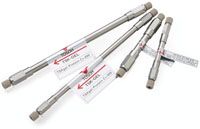TSKgel Protein C4-300 - Speed and resolution for proteins analysis
Tosoh Bioscience is introducing a new reversed phase HPLC column for the separation of intact proteins.

Tosoh Bioscience is introducing a new reversed phase HPLC column for the separation of intact proteins. TSKgel Protein C4-300 consists of a polymerically bonded butyl (C4) phase on wide pore ultrapure silica. The pore size of 300 Å is ideally suited for the HPLC and LC/MS analysis of intact proteins such as antibodies, recombinant proteins and PEGylated proteins. Latest surface modification techniques and endcapping of residual silanol groups reduce undesirable secondary interactions and peak tailing. Hence, peak shape, acid stability and sample recoveries are excellent.
The use of a 3 micron silica particle combined with optimized ligand density and alkyl chain length results in better protein and peptide resolution compared to other leading C4 phases. High speed separations for process control or high throughput screening can be achieved when using a short column of 5 cm length at increased flow. TSKgel Protein C4-300 columns are available in 2 and 4.6 mm ID and 5, 10 and 15 cm length.
The new C4 reversed phase column perfectly fits into the TSKgel HPLC toolbox for biochromatography consisting of high performance SEC, ion exchange, HIC, HILIC and RPC columns.
ref="http://www.separations.eu.tosohbioscience.com/Products/HPLCColumns/ByMode/ReversedPhase/Silica/Protein+RP+Silica/TSKgel+Protein+C4-300.htm">Click here for more detailed information
A Novel LC–QTOF-MS DIA Method for Pesticide Quantification and Screening in Agricultural Waters
May 8th 2025Scientists from the University of Santiago de Compostela developed a liquid chromatography quadrupole time-of-flight mass spectrometry (LC–QTOF-MS) operated in data-independent acquisition (DIA) mode for pesticide quantification in agriculturally impacted waters.
Investigating 3D-Printable Stationary Phases in Liquid Chromatography
May 7th 20253D printing technology has potential in chromatography, but a major challenge is developing materials with both high porosity and robust mechanical properties. Recently, scientists compared the separation performances of eight different 3D printable stationary phases.

.png&w=3840&q=75)

.png&w=3840&q=75)



.png&w=3840&q=75)



.png&w=3840&q=75)



